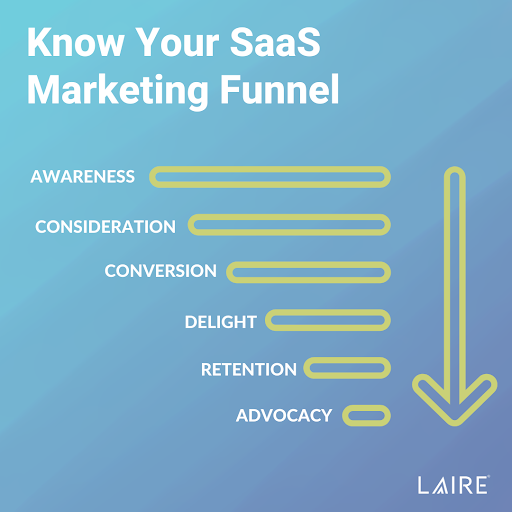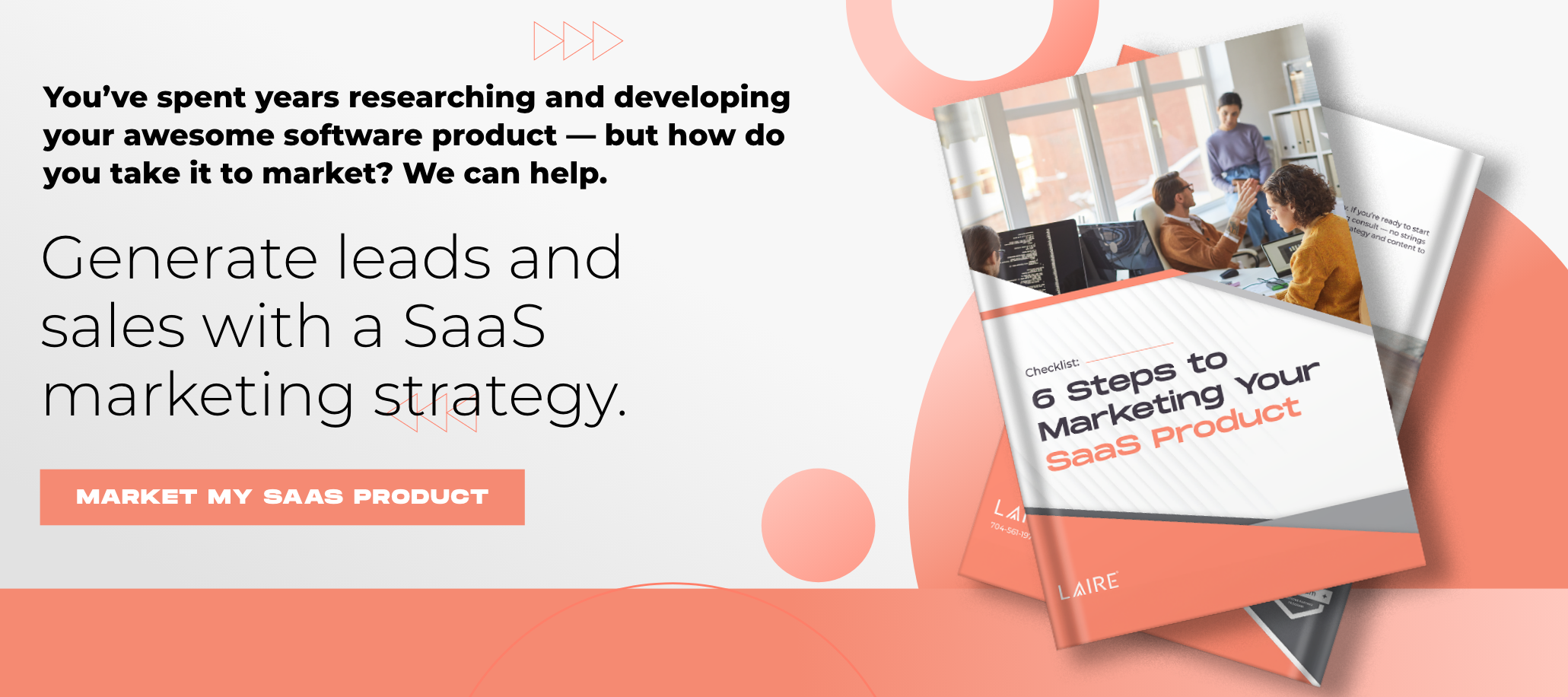In the unique world of SaaS sales and marketing, customers have options to choose from – meaning that to excel against your competitors and grow as a company, demonstrating the advantages of your product is crucial.
Considering that SaaS products and services are entirely digital, specific challenges arise in the selling process. The benefits of your product are less tangible to users compared to traditional products and services, even though you may be providing an excellent digital solution to everyday challenges faced by your target audience. If the results of your service can’t be felt by potential customers during the selling process, they must be shown – that’s where the SaaS marketing funnel comes into play.
What is a SaaS Marketing Funnel?
The SaaS Marketing Funnel provides detailed insight into your customer’s buying journey by breaking down the selling process into defined stages that begin with initial awareness, and extend past the point of purchase. Using funnel concept marketing allows you to take a deeper look into every step your customer experiences – from learning about your brand for the first time to ultimately becoming a loyal consumer. These insights ultimately allow your team to improve marketing strategies and maximize outcomes with future leads – but let’s start by defining and exploring the SaaS marketing stages.

1. Awareness
At this stage at the very top of the tunnel, people are just now discovering your brand and the services you provide. This is the point to make a successful first impression and provide information for curious new leads. The key conversion to success here is to transform strangers to visitors who regularly engage with your brand.
Your brand can take advantage of a variety of strategies to attract new audiences to this initial stage and keep them returning for more, including:
- Blogs
- SEO
- Email marketing
- Social content and engagement
- Paid marketing
- Events
- Community involvement
- SaaS content distribution and promotion
Through these various channels of reaching new users, your brand is charged with the task of communicating why your audience is in need of your product or service. Identify the ideal users that comprise your target audience, and seek to communicate the ways in which your brand is capable of alleviating their primary challenges.
2. Consideration
At this point, users have come to understand the function and purpose of your brand and have engaged with your content two or three times. Now is the time to demonstrate how your products and services effectively solve the issue or set of issues that your audience faces – thus converting these visitors into viable leads.
Note that your funnel becomes smaller at this point – some users at the awareness stage simply won’t be in need of or interested in your product, and won’t progress to the consideration stage. Don’t let this discourage you, the purpose of the SaaS marketing funnel is to identify the best consumers for your brand and guide them to becoming customers. Plus, users who leave the funnel at any stage can potentially return down the line when they are better suited to the solution you offer.
Strategies to effectively progress users down your pipeline at this stage include:
- eBooks
- Whitepapers
- Sales enablement content
- CTAs
- Landing pages
Keep in mind: at this point up until customer conversion, consistent and strategic follow up practices are key in keeping your leads engaged and informed.
3. Decision/Conversion
Now is the time when users are conducting the most in-depth research and making their final comparisons before converting into paying customers. Here is where it’s crucial to demonstrate the ways in which you stand apart from your competitors. A variety of factors come into play for users in making this decision, including price point, special offers, scope of features, and more. Identify the ways in which your brand is the best, and don’t be shy in making them apparent.
During this key phase, you can effectively demonstrate the value of your product using initiatives like:
- Free trials
- Demos
- Webinars
- Case studies
- Customized pricing strategies
4. Delight Stage
Once your lead has been converted into a paying customer, a user enters the delight stage of the funnel – which is just as good as it sounds. This period defines a user’s introduction to the official customer experience, a point at which your brand can optimize the experience by welcoming converted customers with exciting information and helpful resources. Since the goal of SaaS marketing goes beyond a one-time purchase, this phase is crucial in demonstrating why customers made the right decision in choosing your brand and ensuring that they keep returning for your services.
During this onboarding period, you have the opportunity to provide assets like:
- Welcome information
- Sign-on perks
- Product feature outlines
- Benefits of partnership
Basically, you’re showing exactly what your brand is made of and why investing in your product was the best choice for your user – a key step in retaining customers down the line.
5. Retention
Here we reach the key differentiator that separates a SaaS marketing funnel from a standard marketing funnel. In the context of a standard marketing funnel, converting a user to a paid customer is typically the final goal. In the SaaS industry, customer retention beyond initial purchase is key for growth, extending the function of the funnel past the point of sale.
While you’re seeking to gain new customers, it’s important to remember that keeping your existing customers happy is equally important to the growth of your brand. One major reason for this is that acquiring new customers isn’t cheap. With each new customer you bring on board, you face a high customer acquisition cost. This is one major reason why customer retention is crucial for optimizing fiscal growth – in fact, increasing customer retention by only 5% can increase your profit by 25% to 95%.
Focus on maximizing what you provide to your users, including:
Customer Service
In the digital-centric world of SaaS marketing, human interaction with users is limited. Ensuring these few interactions offer a positive experience plays a major role in customer satisfaction. Make sure you have a capable and consistent customer service team that is able to handle the needs of your users and provide a pleasant and painless experience.
Special Offers
Customers love to be reminded of the advantages they’re gaining by partnering with your brand for the long run. Rewarding users for their loyalty and proving that they benefit by sticking with your service is a simple way to keep customers happy and maximize retention. Offer special deals to continued users such as:
- Price discounts for advanced renewal
- Discounts for extended subscription
- Early access to new and exclusive features
Continued Education
Your brand may offer much more than your average existing customer is even aware of. Make efforts to educate your users on the full scope of services they have access to as a customer. Through educational assets like webinars, tutorials, and blogs, you can help customers understand the full range of features they can access – and the benefits they can experience by taking advantage of them. When a user is constantly discovering new solutions your brand can provide, they’re likely to stick around for the long run.
6. Advocacy
You’ve done the work in attracting new customers and providing excellent solutions and experiences to keep them happy. Now, your brand can reap the benefits of creating a marketing funnel by entering the referral stage, where customers advocate for your product to friends and colleagues. Leads gained from referrals are often the highest quality leads, as they’ve been selected by your existing customers and approach your brand already motivated to buy. Setting up a referral program that provides deals to both referrals and referees is a simple yet highly effective strategy to encourage advocacy among your customers.
Mastering Customer Relationship Management
You know why fostering strong customer relationships is essential to maintaining a successful SaaS marketing funnel, but the next question is how?
By breaking down the sales process into such granular steps, marketers gain invaluable insight into the buyer’s journey – but, on the other hand, the journey itself becomes more complex. While your SaaS business experiences the excitement of growth, your team must also overcome the obstacles created by simultaneously attending to multiple leads in various stages of the funnel. Keeping track of all these moving parts can become a major hindrance for your sales team, especially while your marketing team is constantly funneling in new leads.
To help alleviate the complexity of a fully populated SaaS marketing funnel, finding the right Client Relationship Management (CRM) tool is important. These programs help easily track your sales pipeline by organizing leads based on their funnel position, and prompt your team to take action at the most opportune times by reaching out and nurturing leads throughout various stages. With this assistance, your sales team can use their time more efficiently, and provide a more consistent and attentive experience to potential and existing customers.
Gauging SaaS Marketing Funnel Success
The purpose of your SaaS marketing funnel is to generate leads and maximize conversions into paying customers – but how can you tell if your hard work is paying off? To ensure that you’re achieving the right impact with your efforts, you need to determine and track key metrics to gauge success.
Identify Relevant KPIs and Industry Benchmarks
You can’t begin to understand growth if you have no data to compare. To begin, it’s important to identify the specific KPIs that are uniquely relevant to your business goals. Identifying these metrics and tracking them accordingly can help you determine exactly how consumers view your products and services.
Key metrics to consider for a successful SaaS marketing strategy include:
- Customer acquisition cost
- Lifetime customer value
- Customer churn rate
- Recurring revenue
- Customer retention
- Annual growth
- Customer engagement
- Number of sales
Once you’ve identified which KPIs are most relevant in calculating success, you can begin to analyze your strategy and set goals for growth.
Set Goals for Each Stage of Your SaaS Marketing Funnel
For each stage of your SaaS marketing funnel, you should identify specific goals for your team to strive for. In doing so, you benefit the overall function by providing guidance, direction, and insight that allows your team to develop successful strategies within each stage of the funnel. When it comes to keeping track of so many moving pieces within each separate stage, outlining defined goals helps your team ensure that they’re staying on track every step of the way.
Once you’ve identified the who, what, when, where and why of each of the five stages detailed above, you’ll be able to define the goals that each lead should meet before progressing to the next stage of the funnel – allowing you to easily qualify your audience with specific criteria.
As a rule of thumb, all goals you set for your marketing initiatives should be S.M.A.R.T. goals:
Specific: use action words to define exactly what you’re trying to acheive.
Measurable: identify trackable metrics to evaluate success.
Attainable: ensure it’s possible to accomplish with your given resources.
Relevant: align with your strategy’s overall objective.
Time-Based: define a realistic time frame and deadline.
Align Sales and Marketing Initiatives
Creating efficient and effective collaboration between sales and marketing teams is always crucial, but especially when working with the many variables that come with adopting a SaaS marketing funnel strategy. Even the smallest lack of communication can result in significant consequences that hinder the function of your funnel and can even result in lost leads.
Although both departments are ultimately working toward the same goal of converting leads, many workplaces experience scenarios where these two teams are simply not on the same page in regard to the process of getting there. This can be a common situation in regard to SaaS products, which require a more strategic marketing approach in comparison to traditional products and services. When facing a disconnect like this, you can help realign your team with a few simple steps:
Establish a Common Goal
Remind your departments that you are ultimately working toward the same goal: increasing revenue. An easily trackable metric like this helps align your teams by defining success in a way that everybody can understand, serving as a reminder that your teams operate as a united front.
Define Your Target Audience
Get on the same page of exactly who you’re looking to target, or else your teams may struggle to define common goals. Taking this step allows your team to deeper understand the customer’s buying process, and identify the specific stages within it.
Set Guidelines
Your teams benefit greatly when you define specific criteria that qualify a lead to be passed on to the sales team. Establishing this definition allows both departments to understand where any given lead falls during the buying journey – reducing the chance of unqualified leads being prematurely pushed through the sales process.
Fun fact: Hubspot reports that when sales and marketing teams effectively collaborate, companies see 36% higher customer retention and 38% higher sales win rates.
Building Your SaaS Marketing Funnel with the Best
Although the variables that build an excellent SaaS marketing funnel may seem complex, the completed product does wonders in simplifying your sales process and optimizing lead conversions. When you take the time to define an in-depth guide to the buyer’s journey and establish lead nurturing guidelines, your team (and your revenue) reap the results.


